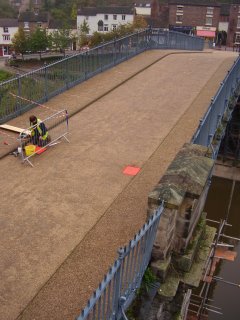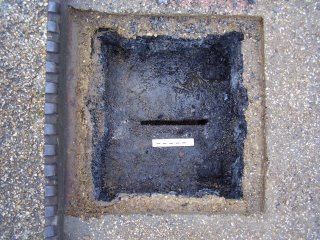The Iron Bridge
Following our extensive work on various aspects of the Iron Bridge in 1999-2000 and 2001-2002, we have returned to the site as part an investigation of the bridge road surface by English Heritage. There are concerns that the penetration of water through the road surface is affecting the deck plates. A series of small trial holes were excavated at various points along the road surface to examine the structure.
 This photo shows the overall surface of the bridge. The red wooden squares mark the location of the holes.
This photo shows the overall surface of the bridge. The red wooden squares mark the location of the holes.
The bridge carries a number of services, including gas, water, electricity and telephone, which may be serving to draw water along the bridge - accelerating corrosion. The deck plates are laid across the bridge and support the road surface. The excavations revealed a series of former road surface layers.
The deck plates themselves are of two types. The original plates, on the main span of 1779, were cast as flat sheets without flanges. Thus water is able to escape between the plates. On the two later (1820s) spans the deck-plates were cast with flanges approximately 50mm high, presumably to ensure a stiffer and more easily-handled casting. Due to the slope of the bridge these catch and hold water, causing corrosion to the downhill sides of the deck plates.
 1779 deck plate. The cast-iron kerb dates from the 1920s and will be removed during future re- surfacing.
1779 deck plate. The cast-iron kerb dates from the 1920s and will be removed during future re- surfacing.
 Join between 1820s deck plates, showing accum- ulation of water against the flange.
Join between 1820s deck plates, showing accum- ulation of water against the flange.
 This photo shows the overall surface of the bridge. The red wooden squares mark the location of the holes.
This photo shows the overall surface of the bridge. The red wooden squares mark the location of the holes.The bridge carries a number of services, including gas, water, electricity and telephone, which may be serving to draw water along the bridge - accelerating corrosion. The deck plates are laid across the bridge and support the road surface. The excavations revealed a series of former road surface layers.
The deck plates themselves are of two types. The original plates, on the main span of 1779, were cast as flat sheets without flanges. Thus water is able to escape between the plates. On the two later (1820s) spans the deck-plates were cast with flanges approximately 50mm high, presumably to ensure a stiffer and more easily-handled casting. Due to the slope of the bridge these catch and hold water, causing corrosion to the downhill sides of the deck plates.
 1779 deck plate. The cast-iron kerb dates from the 1920s and will be removed during future re- surfacing.
1779 deck plate. The cast-iron kerb dates from the 1920s and will be removed during future re- surfacing. Join between 1820s deck plates, showing accum- ulation of water against the flange.
Join between 1820s deck plates, showing accum- ulation of water against the flange.

0 Comments:
Post a Comment
<< Home